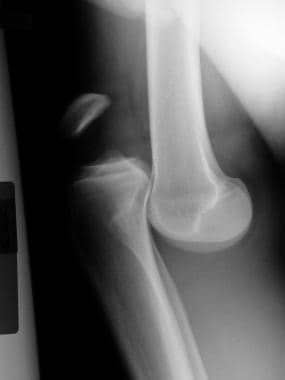Background
Knee dislocations are uncommon. [1] A knee dislocation is defined as complete displacement of the tibia with respect to the femur (see the image below), with disruption of three or more of the stabilizing ligaments. [2, 3] Small avulsion fractures from the ligaments and capsular insertions may be present.
Anatomy
Knee anatomy relevant to dislocations is related to the four main ligament and neurovascular structures. The anterior cruciate ligament (ACL), the posterior cruciate ligament (PCL), the medial collateral ligament (MCL), and the posterolateral corner (lateral collateral ligament [LCL], arcuate complex, popliteus, and biceps femoris), together with the joint capsule, are responsible for knee stability. [2]
Knee dislocation requires injury to at least three of the four main ligaments. The popliteal artery is relatively fixed proximally as it exits a fibrous tunnel at the level of the adductor hiatus, enters the popliteal space, and then is again tethered distally under the soleus. When the knee dislocates, the popliteal artery is stretched and vulnerable to injury. Popliteal artery injury occurs in up to 53% of patients with knee dislocations.
The peroneal nerve is tethered as it winds around the fibular neck. With knee dislocation, the peroneal nerve is at risk. Peroneal nerve injury may occur in up to 23% of patients with knee dislocations. Nearly one half of the patients with peroneal nerve injuries have a permanent deficit. [4]
Fractures about the knee are fairly common in knee dislocations. These can be severe periarticular fractures, commonly tibial plateau fractures or ligamentous and tendinous avulsion fractures. [5] Few data exist on the true incidence of these fractures, in that many reports do not mention them. One unpublished study noted a 35% (eight of 23 cases) incidence of fractures associated with high-velocity knee dislocations (Owens, unpublished data, 2003). The presence of the fracture may alter management and require supplemental bony fixation or may allow ligamentous repair versus reconstruction.
Pathophysiology
Multiple ligament injuries are required for knee dislocation. Generally, both cruciates and one or both collateral ligaments are injured. However, knee dislocations have been described with one of the cruciates intact. It is important to evaluate the competence of each ligament and to consider the possibility of a knee dislocation in knees with three or more ligaments torn. Vigilance is required because of the high incidence of neurovascular injuries associated with knee dislocation (vascular injuries 5-79%, nerve injuries 16-40%).
Classification
Knee dislocations are classified into five types on the basis of the direction of tibial displacement, as follows [6] :
-
Anterior
-
Posterior
-
Medial
-
Lateral
-
Rotational
An anterior knee dislocation usually results from a hyperextension injury to the knee that initially tears the posterior structures and drives the distal femur posterior to the proximal tibia. A posterior knee dislocation usually results from a direct blow to the proximal tibia that displaces the tibia posterior to the distal femur. Valgus forces cause medial dislocations. Varus forces cause lateral dislocations of the knee.
Rotational or rotatory dislocations are the result of indirect rotational forces, usually caused by the body rotating in the opposite direction of a planted foot. Rotatory dislocations can be of four different types, named for the direction of the displaced tibial plateau. For example, posterolateral rotatory dislocation describes a posterior position of the lateral tibial plateau and is the most common rotatory dislocation reported.
Knee dislocations can also be classified as either open or closed and as either reducible or irreducible.
Etiology
Most knee dislocations are the result of high-energy injuries, such as motor vehicle or industrial accidents. They also can occur with low-energy injuries, such as those that occur in sports. The reported mechanisms of injury are variable, but the most common are motor vehicle accidents (50-60%), followed by falls (30%), industrial-related accidents (3-30%), and sports-related injuries (7-20%).
Epidemiology
The Mayo Clinic recorded 14 knee dislocations during an interval of 2 million admissions. [7] In a large series from Los Angeles County Hospital, 53 knee dislocations were reported over a 10-year period. A study from Finland reported 837 knee dislcoations over a period of 14 years and found the incidence to be highest in men aged 18 to 29 years (29 dislocations per 1 million person-years in 2011). [8]
The true incidence of knee dislocations is higher than reported because as many as 50% of knee dislocations spontaneously reduce before patients present to the emergency department.
Prognosis
Multiple outcome studies after surgical intervention for knee dislocation universally report that patients rarely claim that their knee function is normal. [9, 10] Wascher reported results after ACL reconstruction, PCL reconstruction, or both in 13 patients with knee dislocations, and results after a mean of 38 months follow-up care. [11] One patient claimed his knee felt normal, six returned to unrestricted sports activities, and four returned to modified sports.
Shapiro reported the outcome after allograft reconstruction of the ACL and PCL after traumatic knee dislocation. [12] Seven patients had an average of 51 months follow-up care postoperatively. Only one patient had significant pain, three had occasional or rare sensations of knee instability, and all seven were able to return to work or school. Four patients required knee manipulation at an average of 16.8 weeks postoperatively for knee arthrofibrosis. The functional grading was excellent in three, good in three, and fair in one.
Yeh reported the outcome after arthroscopic reconstruction of the PCL with open repair of collateral ligaments and capsule in 23 patietns followed for a mean of 27 months. [13] At the latest follow-up visit, the mean knee extension was 1° and knee flexion was 129.6°.
-
Knee dislocations. Lateral radiograph of anterior knee dislocation.
-
Knee dislocations. MRI showing significant disruption medially and laterally with tibial bone bruise.
-
Knee dislocations. Examination under anesthesia revealing recurvatum and lateral ecchymosis.







